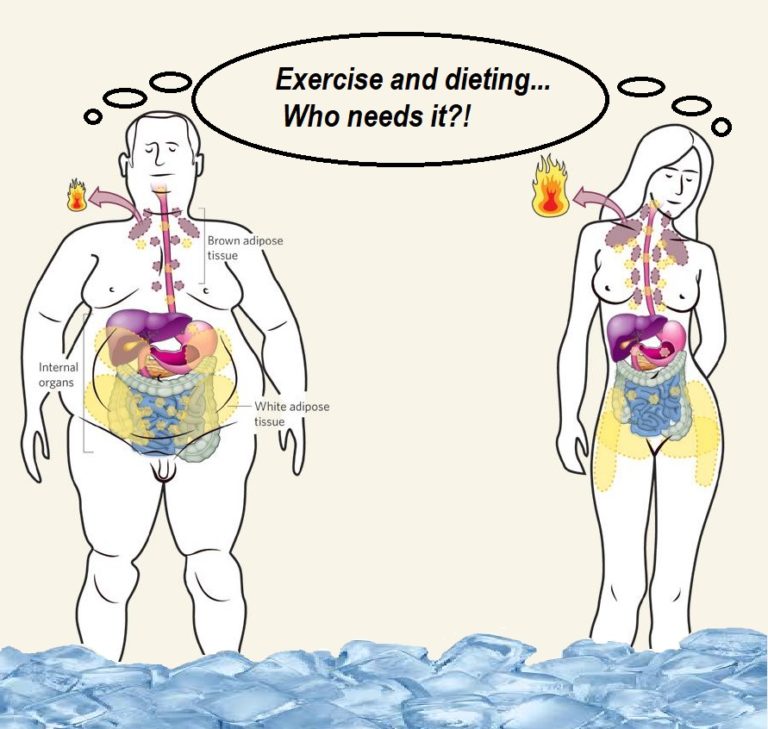
Tackling obesity without exercise or dietary changes? Everyone’s heard of fat tissue (also called adipose tissue), but what about brown adipose tissue (BAT) and “beige” adipose tissue – ever heard of them? Although sounding pretty unappetising, these adipocytes1 share the unique ability of being able to convert chemical energy into heat and, thereby, play a critical role in promoting something called non-shivering thermogenesis – a little-known process that is central to the human species’ ability to spread across the globe and, as an interesting sideline, can potentially help in weight-loss without even having to lift a single barbell or place a tentative trainer on that running machine gathering dust in your garage. Or is it just too good to be true?
BAT & beige adipocytes
Until relatively recently, the physiological role of BAT and beige adipocyte depots were thought to be limited to small mammals and only relevant to humans when they were neonates (newborn infants). Puppy fat or baby fat was thought to all-but disappear with the passing years into adulthood. However, the discovery that there’s more BAT in adult humans than previously thought, has led to studies which show enthusiasm for BAT’s potential role in treating obesity and other disorders caused by sustained positive energy balance (more calories in than out). Adult humans having more BAT than previously thought was revealed 2 3 during routine scans (FDG-PET scans) 4 to detect metastatic cancers. 5 Autopsies were also able to reveal these fat concentrations. 6
Brown & white fat
BAT (often abbreviated to “brown fat”) is found in virtually all mammals, but notably in newborn humans and mammals that hibernate 7 . Of course, the usual white adipose tissue (“white fat”) that we think of when we talk about fat is found in far higher quantities. 8 . The following provides an overview of the differences between the brown and white fat tissue:
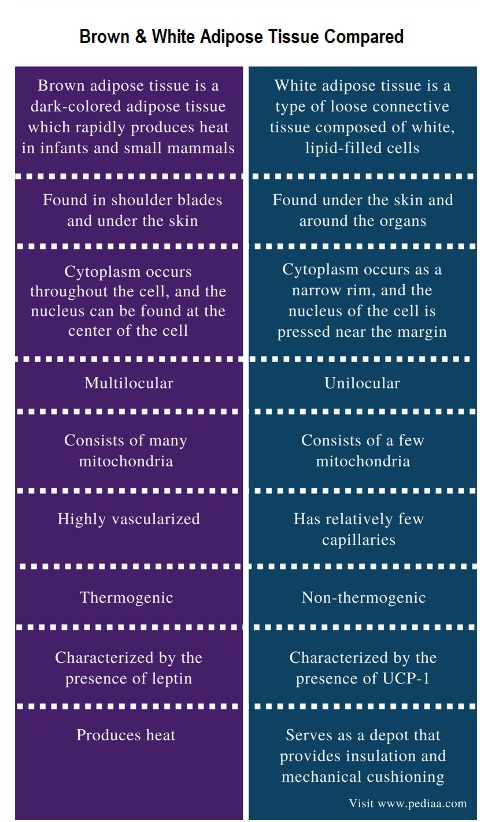
The main differences between brown and white fat can be summarised as:
- white contains a single lipid droplet while brown contains numerous smaller droplets
- brown contains a much much higher number of (iron-containing) mitochondria – hence the brown (rusty) colour of the tissue 9
- brown contains more blood capillaries than white – hence a better oxygen supply, more nutrient-provision and the ability to distribute the produced heat throughout the body
Two types of BAT
BAT itself can also broken down into two types which have similar functions but are located in different cell populations within the body: 10
- brown adipocytes found in comparatively larger separate deposits within the body, and
- “beige” or “brite” (“brown in white”) adipocytes found interspersed within white adipose tissue and which develop out of white adipocytes under the stimulation of the sympathetic nervous system (SNS) 11
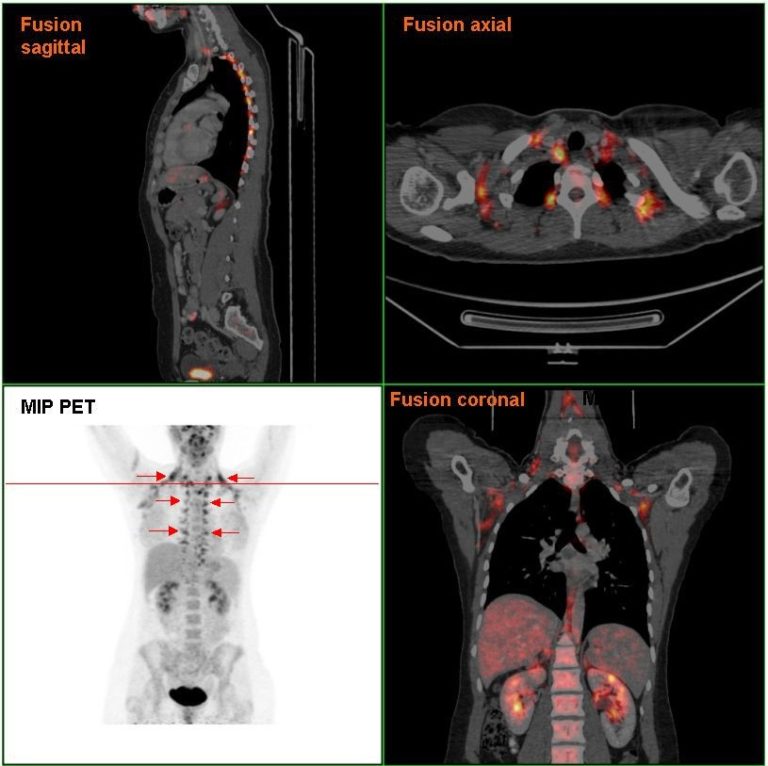
BAT in infants & adults
BAT in infants eventually “turns into” white fat in adulthood. In infancy, however, it tends to be located in the following “depots” within the body:
- interscapular 12
- supraclavicular 13
- suprarenal 14
- pericardial 15
- paraaortic 16
- around the pancreas, kidney and trachea 17
BAT in adults tend to be located in the following depots:
It’s still not absolutely clear whether these adult BAT depots are the “classical” brown or the beige/brite fat. 21 . However, BAT is metabolically active in adult humans 22 and decreases in quantity as we age 23 . Another characteristic of BAT is that it becomes more visible (that is, becomes more metabolically active) with cold exposure – as can be seen by analysing it with PET scans.
BAT & thermoregulation
The primary function of BAT is thermoregulation. That is, ensuring the body remains sufficiently warm in cold environments. It achieves this autonomic heating of the body in two ways: firstly, through shivering thermogenesis (causing muscles to shiver) and, secondly, through non-shivering thermogenesis (as the name suggests – heating the body without shivering) – an adaptive thermogenesis response. The first option, shivering thermogenesis, will certainly warm up the body, but at the expense of using up relatively more precious energy.
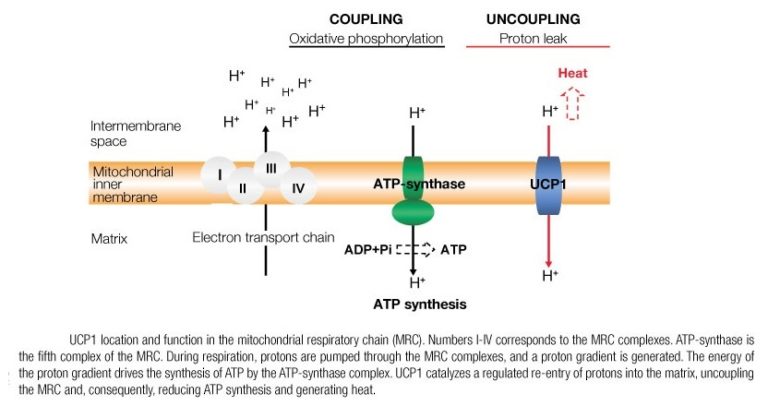 However, the unique ability of BAT to convert energy stores (brown fat) into heat (without needing to use energy-sapping shivering) is achieved through a process within BAT mitochondria (the energy-producing cellular power plants). Instead of the usual process, where ATP (the energy molecule) is produced during oxidative phosphorylation, a protein called thermogenin or UCP1 (Uncoupling Protein 1) promotes a proton leak in the inner membrane of the mitochondria, dissociating the oxidative phosphorylation of substrate from the generation of ATP. In essence, this results in an increase in non-shivering thermogenesis, where the metabolic rate increases, and chemical energy is shunted into heat energy that can then spread around the body via the bloodstream.
However, the unique ability of BAT to convert energy stores (brown fat) into heat (without needing to use energy-sapping shivering) is achieved through a process within BAT mitochondria (the energy-producing cellular power plants). Instead of the usual process, where ATP (the energy molecule) is produced during oxidative phosphorylation, a protein called thermogenin or UCP1 (Uncoupling Protein 1) promotes a proton leak in the inner membrane of the mitochondria, dissociating the oxidative phosphorylation of substrate from the generation of ATP. In essence, this results in an increase in non-shivering thermogenesis, where the metabolic rate increases, and chemical energy is shunted into heat energy that can then spread around the body via the bloodstream.
This means the endothermic organisms (you and me) stand a better chance of survival against unfavourable environmental conditions with the least possible consumption of energy stores 24 . This can be seen in a little more clearly in the following diagram:
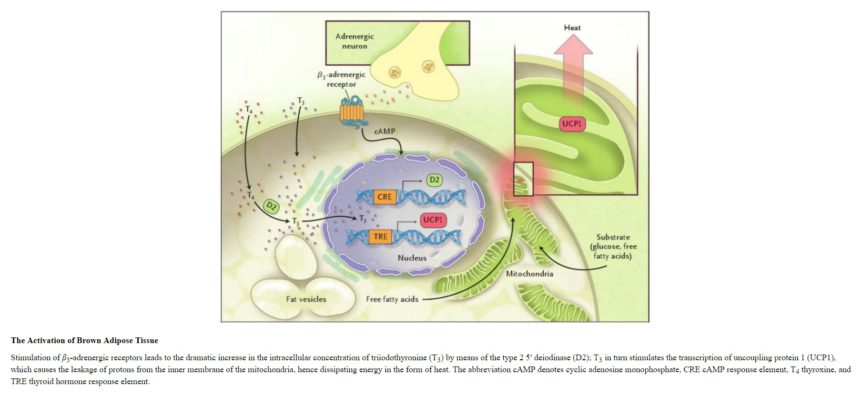
Just to be clear, all cells of endotherms are able to give off heat to some degree, particularly when body temperature is below a regulatory threshold; but BAT is highly specialised for this non-shivering thermogenesis. This is largely because of two of the features mentioned above: firstly, each BAT cell has a higher number of mitochondria compared to typical cells and, secondly, these mitochondria have a higher-than-normal concentration of thermogenin (UCP1) in the inner membrane.
Why do newborns have so much BAT?
In newborn infants, BAT comprises around 5% of body mass (located on the upper half of the spine and toward the shoulders). At this age, infants are at a much higher risk of hypothermia than adults. This is largely because of the following:
Infants have:
- underdeveloped nervous systems that don’t respond quickly and/or appropriately to cold via vasoconstriction (the contraction of blood vessels in and just below the skin)
- inability to move away from cold materials or air currents or towards warmer materials/environments
- low amount of musculature and an inability to shiver (shivering thermogenesis)
- lack of thermal insulation such as subcutaneous fat and fine body hair
- higher ratio of body surface area (proportional to heat loss) to body volume (proportional to heat production)
- higher proportional surface area of the head
- the obvious inability to use adult ways of keeping warm – putting clothes on, exercising, drying their skin, etc
Thus, heat production in BAT provides infants with an alternative means of heat regulation.
Evolutionary advantage of BAT
Mammals (and birds, to some extent) have the unique ability to maintain their core temperature independently of the external environmental temperature. This homeothermic 25 ability has allowed great evolutionary success compared to poikilotherms26 . 27
The main components of this response to temperature are:
- thermal insulation
- non-shivering thermogenesis, and
- shivering thermogenesis 28
From an evolutionary point of view, excess energy expenditure aimed at maintaining core temperature represents a trade-off between survival and the maintenance of energy stores, since energy availability will usually represent a major limiting factor to growth and reproduction. Thus, moving from an insulative response (energy neutral), to a non-shivering and eventually shivering thermogenesis will require a progressively greater dissipation of energy stores, as can be seen in the following chart.
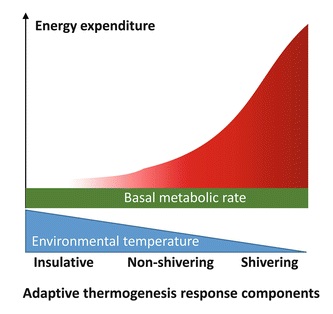
Over recent evolutionary development, humans gained the ability to “control” their environment by using clothes and controlling the temperature in their buildings. As a result, cold exposure is a relatively rare condition and, unless acclimatised, individuals would tend to respond by shivering thermogenesis – where heat is a side product of uncontrolled shivering – also known as muscle fasciculation 29
Losing weight & improving health with BAT
Recent discoveries regarding BAT may, it’s claimed, lead to new methods of weight loss, since brown fat (when exposed to cold temperatures) takes calories from normal fat and burns it. As well as this, adaptive (non-shivering) thermogenesis also appears to promote glucose disposal. To test this weight-loss ability of BAT, it would involve exposing subjects to cold temperatures and monitoring whether they do, in fact, lose weight without having to exercise or change dietary patterns. The following is a selection of some BAT studies that throw some light on this subject.
A 1961 study 30 when individuals had prolonged exposure to cold, showed that they became resilient and stopped displaying shivering thermogenesis, indicating that other mechanisms were being recruited.
In 2009, four separate studies 31 32 33 34 indicated clearly that BAT was present in a significant number of adults and that there was a correlation between its presence and activity related to indices of healthy metabolism.
In 2010, a study 35 showed that there was an inverse correlation between BAT activity and between obesity, diabetes and ageing – that is, the more active BAT was, the less obesity, diabetes and ageing was seen.
Naturally, up to this point, the relationship was one of correlation and no causal mechanism had been established. However, researchers were very interested in finding out more about the capacity and activity of human BAT as a therapeutic means of treating the various metabolic consequences of obesity. The majority of the consequent studies focused on this BAT adaptive thermogenesis response by exposing volunteers to cold.
A 2011 study 36 exposed individuals to short but intense cold (e.g. immersing a limb in ice-cold water). Whilst they showed that this does indeed increase energy expenditure, it’s a method that fails completely to correspond with day-to-day experience and is impossible to sustain over time.
Additional research demonstrated that such extreme cold exposure was not necessary to stimulate sustained physiologic adaptive thermogenesis. It could be stimulated by even mild cold exposure as that controlled within normal (and bearable) climate-controlled buildings. This was shown in a 2010 crossover study 37 which looked at the effects of the adaptive thermogenesis response to minimal changes in environmental temperature. Healthy volunteers underwent two 12-hour periods in a whole room calorimeter (Metabolic Chamber) at 19 and 24 °c to monitor energy expenditure (EE). Results indicated that such minimal modulation of environmental temperature was sufficient to increase EE by around 6%. Might not seem much but, if projected over a 24 hour period, it would represent a drop of 100 kcal in an individual of between 70-80 kg.
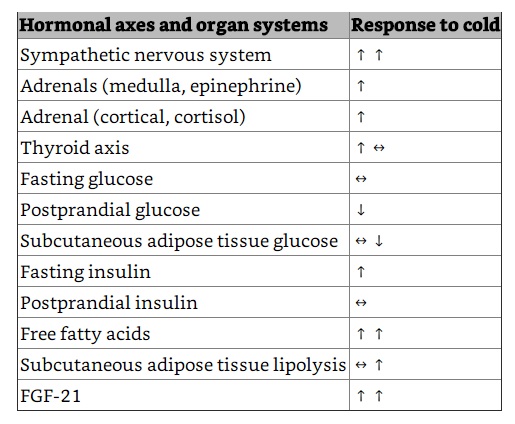
In addition to burning extra calories, exposure to mild cold (with the resulting increase in non-shivering thermogenesis) was shown to be sufficient to drive an adrenergic response 38 , which promotes lipolysis39 (with fatty acids being the preferred substrate in BAT depots) and increased postprandial glucose disposal. Additionally, the intervention generated an increase in cortisol 40 and a state of relative insulin resistance during fasting, which indicate an activation of the stress response. These, and other responses are shown in the adjacent table.
The researchers point out that, although the magnitude of this change may appear insignificant – only one fifth of the negative energy balance recommended to achieve sustained weight loss – it is relevant to note that, over a 1-year period (all things being equal), these differences would be equivalent to a 20-day fast and to a daily 30-min walk at a moderate pace.
A subsequent 2013 study 41 confirmed BAT contributes to energy expenditure (EE) in response to mild cold exposure – namely, 12-hour metabolic chamber exposure to either 19 or 24 ° C.
Two other 2013 studies showed, in the first case 42 , that a short-term, moderate (10 days acclimatisation with exposure at 17 ° C daily for 2 hours) cold exposure was sufficient to increase the quantity of BAT, and, in the second case 43 , that a longer period of time (6 weeks acclimatisation with exposure at 17 ° C daily for 2 hours) resulted in “significant fat mass reduction“- as shown in the following photos and chart:
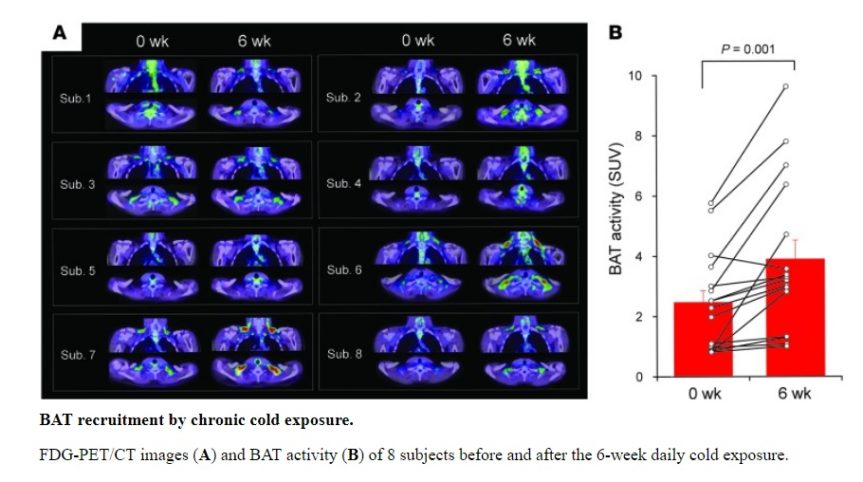
BAT activation was shown to improve glucose homeostasis 44 and insulin sensitivity 45 in humans. Additional studies 46 47 looked at BAT and the hormone FGF-21 (fibroblast growth factor 21 production). FGF-21 is a critical metabolic regulator that governs glucose and lipid (fat) metabolism and plays an important role in the treatment of metabolic diseases, such as T2D (type 2 diabetes) and obesity. In T1D (type 1 diabetes), FGF-21 also reduces blood glucose levels and prevents diabetic complications. It was demonstrated that BAT activation through cold exposure can up-regulate circulating FGF-21 in humans by 37%. FGF21 improves insulin sensitivity and glucose metabolism which may partially explain its longevity promoting benefits.
This offers hope for those with impaired insulin function who might benefit from BAT activation. And it’s not just those with clinically impaired insulin function, such as type 2 diabetics, who could benefit from this. Over time, even mildly elevated blood glucose levels in otherwise healthy non-diabetic humans are associated with other physiological damage. This has been shown to result in higher levels of the damaging AGE’s (advanced glycation end products – found in animal products, processed and fried/barbecued/roasted fatty foods), as well as damage to the brain, eyes, tendons, endothelial cells and the cardiovascular system 48 49 50 .
In a longer 2014 study 51 over four consecutive months, environmental temperature was modulated overnight – 24 ° C (run-in period), (cold acclimatisation), 24 ° C (wash-out period), and 30 ° C (heat acclimatisation). After a month of exposure to mild cold (19 ° C ), BAT volume and activity almost doubled, but after a month of exposure to warm temperature (30 ° C), BAT activity was negligible. The researchers commented that: “Remarkably, the increase in BAT activity following the cold acclimatisation was accompanied by a significant increase in postprandial glucose disposal, but only during mild cold exposure.”
One study 52 looked at levels of irisin (a relatively newly discovered hormone) as a result of both intense exercise and cold exposure. Irisin is nicknamed the “exercise hormone” since it’s released during moderate aerobic endurance activity and is known to be an anti-obesity and anti-diabetes hormone that regulates fat tissue and blood sugar, improving insulin sensitivity, bone quality/quantity 53 54 , and building lean muscle mass. In essence, irisin is thought to help reduce obesity by converting white fat to brown fat 55 . Being that irisin is released by muscles during physical exercise 56 , if cold-exposure also releases irisin, then perhaps the metabolic benefits of such exposure would be similar to those when irisin is released through exercise. And, indeed, this study demonstrated that this appears to be the case.
And irisin has other interesting effects. A study 57 on the reasons why healthy centenarians are healthy noted that they tend to have increased serum irisin levels, whilst irisin levels were significantly lower in younger patients with myocardial infarction 58 . So, although somewhat an aside to the main thrust of this blog, such findings are likely to prompt further research into the role of irisin in vascular disorders and life span extension.
Another hormone, adiponectin 59 , has associations with both BAT activation and centenarians. It’s been shown 60 that when BAT is activated through cold exposure, adiponectin levels increase within just two hours, resulting in a 70% increase in circulating adiponectin in adult men. Interestingly, both male and female centenarians (as well as their offspring) have been found 61 both to have genetics which boost adiponectin and to have generally higher circulating levels of adiponectin. This suggests a further link between BAT activation and longevity – this time because of the increased production of adiponectin. Furthermore, these high concentrations of plasma adiponectin in centenarians were associated 62 with other favourable metabolic factors as well as with lower levels of C-reactive protein 63 and E-selectin64 . It was mentioned earlier that BAT activation results in the production of FGF-21 – a hormone that improves insulin sensitivity and glucose metabolism. The latter benefits may explain why this hormone has been shown 46 to play a role in promoting longevity in humans.
In relation to fat and irisin, it was shown 65 that applying irisin to human preadipocytes (cells that can be transformed into different fat cells through the process of adipogenesis) , ordinary white adipocytes could be changed into beige adipocytes. This helps confirm the role of irisin as a myokine66 that can expand beige adipocyte mass, increasing the non-shivering thermogenesis capacity and, thereby, promoting a shift from inefficient and non-sustainable shivering thermogenesis to more efficient and sustainable non-shivering thermogenesis. In the following diagram, FGF-21 (fibroblast growth factor 21) promotes BAT’s activity of cold-induced non-shivering thermogenesis in humans.
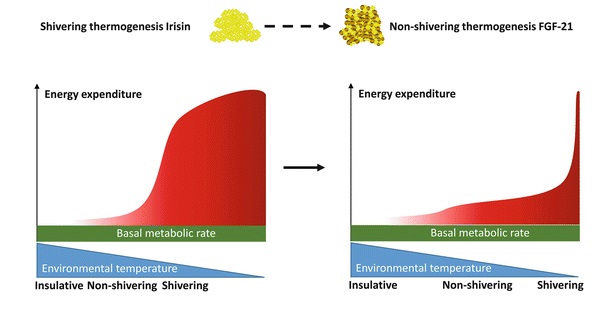
All the above studies indicate both that human BAT is extremely plastic, and that activation via cold exposure is necessary to generate a significant metabolic response.
Final thoughts
So, merely reducing the environmental temperature in your home could help to lose some body weight (represented by an additional energy expenditure of around 100 kcal) without actually undergoing exercise or changing one’s dietary habits. However, the amount of body fat you could lose through undergoing even colder and, consequently, more uncomfortable temperatures is something that I can’t imagine many people wanting to opt for as a weight-loss method.
Of course, integrating a bit of low temperature “therapy” might reduce one’s heating bills. And, of course, there is another weight-loss method associated with temperature modulation – namely, sweating your socks off in a sauna, albeit really just water that you’ll lose, and you’ll put the weight back on pretty soon afterwards when you rehydrate.
However, there is another simple non-exercise/non-dieting weight-loss method which is similar in effect to turning down the thermostat – namely, something called a standing desk. A standing desk is simply a matter of raising the height of one’s table (and hence the computer , book or paperwork thereon) and standing instead of sitting. Interestingly, this method has been shown 67 to increase calories burnt (in this case in young schoolchildren):
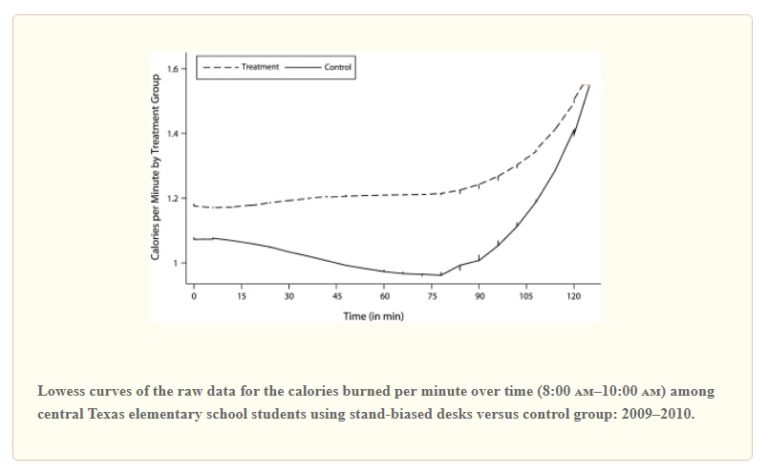
Another study 68 found that standing burned an extra 0.15 calories per minute, on average, compared with sitting. Men burned an extra 0.2 calories per minute while standing, which was twice as much as women, who burned an extra 0.1 calories. This was because men they typically have more muscle mass than women. This would mean that a person weighing around 63 kg (140 pounds/10 stones), replacing sitting with standing for six hours a day would burn an extra 54 calories per day.
Naturally, pharmaceutical companies may well try to come up with a “magic pill” that will stimulate BAT activity without the need for subjecting oneself to cold temperatures – maybe an injection or pill to stimulate BAT activity without having to ensure cold temperatures; but experience teaches us that most of these pharmaceutical wonder cures have unpleasant side effects and rarely prove as effective as their manufacturers initially claim.
So, whether of itself, or even when combined with another simple non-exercise/non-dietary change weight-loss method, it would seem that the benefits are interesting, though not comparable with the weight-loss benefits of a combination of exercise and eating a low-fat plant-based diet.

References & Notes
- Adipocytes are cells specialised in fat storage and are found in connective tissue. [↩]
- Hany TF, Gharehpapagh E, Kamel EM, Buck A, Himms-Hagen J, von Schulthess GK (2002) Brown adipose tissue: a factor to consider in symmetrical tracer uptake in the neck and upper chest region. Eur J Nucl Med Mol Imaging 29: 1393– 1398. [↩]
- Agrawal A, Nair N, Baghel NS (2009) A novel approach for reduction of brown fat uptake on FDG PET. Br J Radiol 82: 626– 631. [↩]
- PET stands for positron-emission tomography (PET) and is a nuclear medicine functional imaging technique that is used to observe metabolic processes in the body as an aid to the diagnosis of disease. FDG stands for fludeoxyglucose, an analogue of glucose – the biologically active tracer molecule chosen for this type of scan. [↩]
- Yeung HW, Grewal RK, Gonen M, Schöder H, Larson SM (2003). “Patterns of (18)F-FDG uptake in adipose tissue and muscle: a potential source of false-positives for PET”. J Nucl Med. 44 (11): 1789–96. [↩]
- Huttunen P, Hirvonen J, Kinnula V (1981) The occurrence of brown adipose tissue in outdoor workers. Eur J Appl Physiol Occup Physiol 46: 339– 345. [↩]
- Gesta S, Tseng YH, Kahn CR (October 2007). “Developmental origin of fat: tracking obesity to its source”. Cell. 131 (2): 242–56. [↩]
- Cinti S (2005). “The adipose organ”. Prostaglandins Leukot Essent Fatty Acids. 73 (1): 9–15. [↩]
- Enerbäck S (2009). “The origins of brown adipose tissue”. New England Journal of Medicine. 360 (19): 2021–2023. [↩]
- Wu J, Boström P, Sparks LM, Ye L, Choi JH, Giang AH, Khandekar M, Virtanen KA, Nuutila P, Schaart G, Huang K, Tu H, van Marken Lichtenbelt WD, Hoeks J, Enerbäck S, Schrauwen P, Spiegelman BM (2012). “Beige adipocytes are a distinct type of thermogenic fat cell in mouse and human”. Cell. 150 (2): 366–76. [↩]
- In response to a stressor, the sympathetic nervous system orchestrates what you familiarly call the fight-or-flight response. It increases muscle blood flow and tension, dilates pupils, accelerates heart rate and respiration, and increases perspiration and arterial blood pressure. [↩]
- Interscapular – of, relating to, situated in, or occurring in the region between the scapulae, shoulder blades [↩]
- Supraclavicular – of, relating to, situated in, or occurring in the region above the scapulae, shoulder blades [↩]
- Suprarenal – of, relating to, situated in, or occurring in the region above or anterior to the kidneys [↩]
- Pericardial – of, relating to, situated in, or occurring in the pericardium, two thin layers of a sac-like tissue that surround the heart, which hold it in place and help it work [↩]
- Paraaortic – of, relating to, situated in, or occurring in the region of the front of the lumbar vertebrae near the aorta [↩]
- Heaton JM (1972). “The distribution of brown adipose tissue in the human”. J Anat. 112 (Pt 1): 35–9. [↩]
- Paravertebral – of, relating to, situated in, or occurring in the region on each side of the vertebrae [↩]
- Mediastinal – of, relating to, situated in, or occurring in the region in the middle of the chest that lies between the sternum (breastbone) and spinal column. The area contains vital organs including the heart, oesophagus, and trachea. [↩]
- van Marken Lichtenbelt WD, Vanhommerig JW, Smulders NM, Drossaerts JM, Kemerink GJ, Bouvy ND, Schrauwen P, Teule GJ (2009). “Cold-activated brown adipose tissue in healthy men”. N Engl J Med. 360 (15): 1500–8. [↩]
- Lidell ME, Betz MJ, Enerbäck S (2014). “Two types of brown adipose tissue in humans”. Adipocyte. 3 (1): 63–6. [↩]
- Saito M, Okamatsu-Ogura Y, Matsushita M, Watanabe K, Yoneshiro T, Nio-Kobayashi J, Iwanaga T, Miyagawa M, Kameya T, Nakada K, Kawai Y, Tsujisaki M (2009). “High incidence of metabolically active brown adipose tissue in healthy adult humans: effects of cold exposure and adiposity”. Diabetes. 58 (7): 1526–31. [↩]
- Graja A, Schulz TJ (2015). “Mechanisms of aging-related impairment of brown adipocyte development and function”. Gerontology. 61 (3): 211–7. [↩]
- Brown adipose tissue— when it pays to be inefficient. N Engl J Med 2009. 360: 1553– 1556. [↩]
- Homeotherms maintain thermal homeostasis [↩]
- A poikilotherm is an animal whose internal temperature varies considerably and depends on the external environment. Reptiles and fish are poikilotherms. [↩]
- Vianna CR, Hagen T, Zhang CY, Bachman E, Boss O, Gereben B, Moriscot AS, Lowell BB, Bicudo JE, Bianco AC (2001) Cloning and functional characterization of an uncoupling protein homolog in hummingbirds. Physiol Genomics 5: 137– 145. [↩]
- Celi FS, Le TN, Ni B (2015) Physiology and relevance of human adaptive thermogenesis response. Trends Endocrinol Metab 26: 238– 247. [↩]
- Fasciculation is a brief spontaneous contraction affecting a small number of muscle fibres, often causing a flicker of movement under the skin. [↩]
- Davis TR (1961) Chamber cold acclimatization in man. J Appl Physiol 16: 1011– 1015. [↩]
- Cypess AM, Lehman S, Williams G, Tal I, Rodman D, Goldfine AB, Kuo FC, Palmer EL, Tseng YH, Doria A, Kolodny GM, Kahn CR (2009) Identification and importance of brown adipose tissue in adult humans. N Engl J Med 360: 1509– 1517. [↩]
- Virtanen KA, Lidell ME, Orava J, Heglind M, Westergren R, Niemi T, Taittonen M, Laine J, Savisto NJ, Enerback S, Nuutila P (2009) Functional brown adipose tissue in healthy adults. N Engl J Med 360: 1518– 1525. [↩]
- van Marken Lichtenbelt WD, Vanhommerig JW, Smulders NM, Drossaerts JM, Kemerink GJ, Bouvy ND, Schrauwen P, Teule GJ (2009) Cold-activated brown adipose tissue in healthy men. N Engl J Med 360: 1500– 1508. [↩]
- Saito M, Okamatsu-Ogura Y, Matsushita M, Watanabe K, Yoneshiro T, Nio-Kobayashi J, Iwanaga T, Miyagawa M, Kameya T, Nakada K, Kawai Y, Tsujisaki M (2009) High incidence of metabolically active brown adipose tissue in healthy adult humans: effects of cold exposure and adiposity. Diabetes 58: 1526– 1531. [↩]
- Pfannenberg C, Werner MK, Ripkens S, Stef I, Deckert A, Schmadl M, Reimold M, Haring HU, Claussen CD, Stefan N (2010) Impact of age on the relationships of brown adipose tissue with sex and adiposity in humans. Diabetes 59: 1789– 1793. [↩]
- Yoneshiro T, Aita S, Matsushita M, Kameya T, Nakada K, Kawai Y, Saito M (2011) Brown adipose tissue, whole-body energy expenditure, and thermogenesis in healthy adult men. Obesity (Silver Spring) 19: 13– 16. [↩]
- Celi FS, Brychta RJ, Linderman JD, Butler PW, Alberobello AT, Smith S, Courville AB, Lai EW, Costello R, Skarulis MC, Csako G, Remaley A, Pacak K, Chen KY (2010) Minimal changes in environmental temperature result in a significant increase in energy expenditure and changes in the hormonal homeostasis in healthy adults. Eur J Endocrinol 163: 863– 872. [↩]
- Andrenergic relates to nerve cells in which adrenaline, noradrenaline, or a similar substance acts as a neurotransmitter. The result of this is that there is a stimulation of the sympathetic nervous system (SNS), which is responsible for the fight-or-flight response, which is triggered for example by exercise or fear causing situations. This response dilates pupils, increases heart rate, mobilises energy, and diverts blood flow from non-essential organs to skeletal muscle. These effects together tend to increase physical performance/energy usage momentarily. [↩]
- Lipolysis is the breakdown of fats and other lipids by hydrolysis to release fatty acids. [↩]
- Cortisol helps to control blood sugar levels, regulate metabolism, help reduce inflammation, and assist with memory formulation. It has a controlling effect on salt and water balance and helps control blood pressure. [↩]
- Chen KY, Brychta RJ, Linderman JD, Smith S, Courville A, Dieckmann W, Herscovitch P, Millo CM, Remaley A, Lee P, Celi FS (2013) Brown fat activation mediates cold-induced thermogenesis in adult humans in response to a mild decrease in ambient temperature. J Clin Endocrinol Metab 98: E1218– E1223. [↩]
- van der Lans AA, Hoeks J, Brans B, Vijgen GH, Visser MG, Vosselman MJ, Hansen J, Jorgensen JA, Wu J, Mottaghy FM, Schrauwen P, van Marken Lichtenbelt WD (2013) Cold acclimation recruits human brown fat and increases nonshivering thermogenesis. J Clin Invest 123: 3395– 3403. [↩]
- Yoneshiro T, Aita S, Matsushita M, Kayahara T, Kameya T, Kawai Y, Iwanaga T, Saito M (2013) Recruited brown adipose tissue as an antiobesity agent in humans. J Clin Invest 123: 3404– 3408. [↩]
- Stanford, Kristin I.; Middelbeek, Roeland J.W.; Townsend, Kristy L.; An, Ding; Nygaard, Eva B.; Hitchcox, Kristen M.; Markan, Kathleen R.; Nakano, Kazuhiro; Hirshman, Michael F. (2013-01-02). “Brown adipose tissue regulates glucose homeostasis and insulin sensitivity”. The Journal of Clinical Investigation. 123 (1): 215–223. [↩]
- Chondronikola, Maria; Volpi, Elena; Børsheim, Elisabet; Porter, Craig; Annamalai, Palam; Enerbäck, Sven; Lidell, Martin E.; Saraf, Manish K.; Labbe, Sebastien M. (2014-07-23). “Brown Adipose Tissue Improves Whole Body Glucose Homeostasis and Insulin Sensitivity in Humans”. Diabetes. 63 (12): 4089–99. [↩]
- Camporez, João Paulo G.; Jornayvaz, François R.; Petersen, Max C.; Pesta, Dominik; Guigni, Blas A.; Serr, Julie; Zhang, Dongyan; Kahn, Mario; Samuel, Varman T. (2013-09-01). “Cellular mechanisms by which FGF21 improves insulin sensitivity in male mice”. Endocrinology. 154 (9): 3099–3109. [↩] [↩]
- Lee, Paul; Linderman, Joyce D.; Smith, Sheila; Brychta, Robert J.; Wang, Juan; Idelson, Christopher; Perron, Rachel M.; Werner, Charlotte D.; Phan, Giao Q. (2014-02-04). “Irisin and FGF21 are cold-induced endocrine activators of brown fat function in humans”. Cell Metabolism. 19 (2): 302–309. [↩]
- Bjørnholt, J. V.; Erikssen, G.; Aaser, E.; Sandvik, L.; Nitter-Hauge, S.; Jervell, J.; Erikssen, J.; Thaulow, E. (1999-01-01). “Fasting blood glucose: an underestimated risk factor for cardiovascular death. Results from a 22-year follow-up of healthy nondiabetic men”. Diabetes Care. 22 (1): 45–49. [↩]
- Snedeker, Jess G. (2016-01-01). How High Glucose Levels Affect Tendon Homeostasis. Advances in Experimental Medicine and Biology. 920. pp. 191–198. [↩]
- Cherbuin, Nicolas; Sachdev, Perminder; Anstey, Kaarin J. (2012-09-04). “Higher normal fasting plasma glucose is associated with hippocampal atrophy The PATH Study”. Neurology. 79 (10): 1019–1026. [↩]
- Lee P, Smith S, Linderman J, Courville AB, Brychta RJ, Dieckmann W, Werner CD, Chen KY, Celi FS (2014b) Temperature-acclimated brown adipose tissue modulates insulin sensitivity in humans. Diabetes 63: 3686– 3698. [↩]
- Lee P, Linderman JD, Smith S, Brychta RJ, Wang J, Idelson C, Perron RM, Werner CD, Phan GQ, Kammula US, Kebebew E, Pacak K, Chen KY, Celi FS (2014c) Irisin and FGF21 are cold-induced endocrine activators of brown fat function in humans. Cell Metab 19: 302– 309. [↩]
- Devlin, Maureen J. (2015-02-01). “The “Skinny” on brown fat, obesity, and bone”. American Journal of Physical Anthropology. 156: 98–115. [↩]
- Lee, P.; Brychta, R.J.; Collins, M.T.; Linderman, J.; Smith, S.; Herscovitch, P.; Millo, C.; Chen, K.Y.; Celi, F.S. (2013-04-01). “Cold-activated brown adipose tissue is an independent predictor of higher bone mineral density in women”. Osteoporosis International. 24 (4): 1513–1518. [↩]
- Colaianni, Graziana; Cuscito, Concetta; Mongelli, Teresa; Pignataro, Paolo; Buccoliero, Cinzia; Liu, Peng; Lu, Ping; Sartini, Loris; Di Comite, Mariasevera (2015-09-29). “The myokine irisin increases cortical bone mass”. Proceedings of the National Academy of Sciences of the United States of America. 112 (39): 12157–12162. [↩]
- Harmon, Katherine. “Newly Discovered Hormone Boosts Effects of Exercise, Could Help Fend Off Diabetes”. [↩]
- Emanuele, Enzo; Minoretti, Piercarlo; Pareja-Galeano, Helios; Sanchis-Gomar, Fabian; Garatachea, Nuria; Lucia, Alejandro (2014-09-01). “Serum irisin levels, precocious myocardial infarction, and healthy exceptional longevity”. The American Journal of Medicine. 127 (9): 888–890. [↩]
- Myocardial infarction is commonly known as a heart attack, and occurs when blood flow decreases or stops to a part of the heart, causing damage to the heart muscle. The most common symptom is chest pain or discomfort which may travel into the shoulder, arm, back, neck, or jaw. [↩]
- Adiponectin is a protein hormone that is produced by fat cells. Its physiological effects include the reduction of inflammation and atherogenesis (the formation of fatty deposits in the arteries) and enhancement of the response of cells to insulin. [↩]
- Imbeault, Pascal; Dépault, Isabelle; Haman, François (2009-04-01). “Cold exposure increases adiponectin levels in men”. Metabolism: Clinical and Experimental. 58 (4): 552–559. [↩]
- Atzmon, Gil; Pollin, Toni I.; Crandall, Jill; Tanner, Keith; Schechter, Clyde B.; Scherer, Philipp E.; Rincon, Marielisa; Siegel, Glenn; Katz, Micol (2008-05-01). “Adiponectin levels and genotype: a potential regulator of life span in humans”. The Journals of Gerontology. Series A, Biological Sciences and Medical Sciences. 63 (5): 447–453. [↩]
- Arai, Yasumichi; Nakazawa, Susumu; Kojima, Toshio; Takayama, Michiyo; Ebihara, Yoshinori; Shimizu, Ken-ichirou; Yamamura, Ken; Homma, Satoki; Osono, Yasunori (2006-02-27). “High adiponectin concentration and its role for longevity in female centenarians”. Geriatrics and Gerontology International. 6 (1): 32–39. [↩]
- High C-reactive protein (CRP) levels in your blood indicate inflammation in your body, possibly indicating an infection or other condition. [↩]
- E-selectin is also associated with inflammation, mediating leukocyte rolling (adhesion) on activated endothelial cells at inflammatory sites. It may also support tumour cell adhesion during hematogenous metastasis (cancer spread) and may play roles in angiogenesis (cancer development) and haematopoiesis (production of blood cells). [↩]
- Lee P, Werner CD, Kebebew E, Celi FS (2014a) Functional thermogenic beige adipogenesis is inducible in human neck fat. Int J Obes (Lond) 38: 170– 176. [↩]
- A myokine is one of several hundred cytokines or other small proteins and proteoglycan peptides that are produced and released by muscle cells in response to muscular contractions. [↩]
- Am J Public Health. 2011 August; 101(8): 1433–1436. The Impact of Stand-Biased Desks in Classrooms on Calorie Expenditure in Children. Mark E. Benden et al. [↩]
- Eur J Prev Cardiol. 2018 Mar;25(5):522-538. Differences of energy expenditure while sitting versus standing: A systematic review and meta-analysis. Saeidifard F et al. [↩]